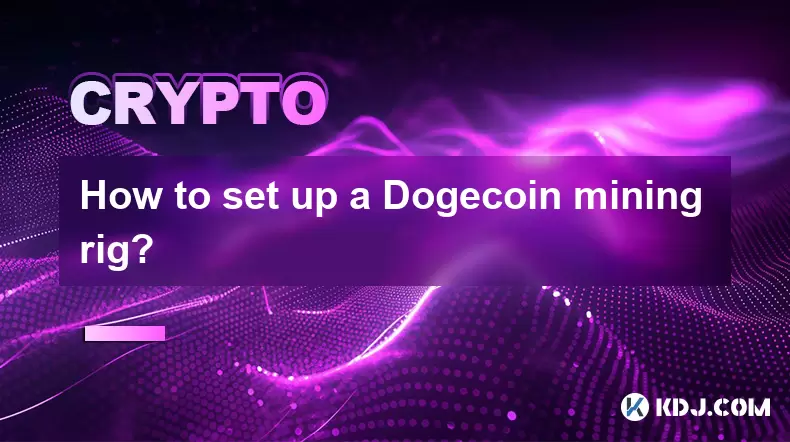-
 bitcoin
bitcoin $112195.049338 USD
2.42% -
 ethereum
ethereum $4124.915858 USD
2.81% -
 tether
tether $1.000570 USD
0.02% -
 xrp
xrp $2.861568 USD
2.25% -
 bnb
bnb $1000.346670 USD
3.04% -
 solana
solana $209.070819 USD
3.38% -
 usd-coin
usd-coin $0.999870 USD
0.02% -
 dogecoin
dogecoin $0.235379 USD
2.65% -
 tron
tron $0.335681 USD
-0.20% -
 cardano
cardano $0.803501 USD
3.38% -
 hyperliquid
hyperliquid $47.120881 USD
3.56% -
 chainlink
chainlink $21.501300 USD
3.44% -
 ethena-usde
ethena-usde $1.000571 USD
0.02% -
 avalanche
avalanche $29.793378 USD
3.62% -
 stellar
stellar $0.366964 USD
2.42%
How to set up a Bitcoincoin mining rig?
Dogecoin mining uses the Scrypt algorithm, making it GPU-friendly and offering faster block times of about one minute per block.
Jul 07, 2025 at 07:49 pm

Understanding the Basics of Dogecoin Mining
Dogecoin (DOGE) is a cryptocurrency that uses the Scrypt algorithm, making it different from Bitcoin, which uses SHA-256. This means you can mine Dogecoin using GPUs or specialized ASIC miners designed for Scrypt-based coins like Litecoin. Before diving into hardware setup, it's essential to understand how mining works in the Dogecoin network. Miners validate transactions by solving complex cryptographic puzzles, and in return, they are rewarded with DOGE tokens.
One key aspect of Dogecoin mining is its block time, which is approximately one minute per block. This fast confirmation speed makes Dogecoin more accessible for frequent mining rewards compared to other cryptocurrencies. However, this also means that the network difficulty adjusts frequently, so having efficient hardware and software becomes crucial.
Selecting the Right Hardware for Mining Dogecoin
To set up a successful Dogecoin mining rig, you must choose appropriate hardware components. While ASIC miners offer high hash rates and energy efficiency, they are often expensive and may not be easily available. For most individual miners, using a GPU-based mining rig remains the preferred choice.
Here are some recommended components:
- GPU(s): AMD Radeon RX 570 or NVIDIA GeForce GTX 1070 and above provide good performance for Scrypt mining.
- Motherboard: Choose one that supports multiple PCIe slots for multi-GPU setups, such as B250 or X370 models.
- Power Supply Unit (PSU): A reliable PSU with sufficient wattage is essential. For a 6-GPU rig, a 1200W to 1500W PSU is typically required.
- CPU: A basic processor like Intel Celeron or Ryzen 3 is sufficient for mining purposes.
- RAM: 4GB to 8GB of RAM is adequate for mining operations.
- Storage: A simple USB drive or SSD with at least 16GB of storage will suffice for the operating system and mining software.
- Cooling System: Proper ventilation and fans help maintain optimal GPU temperatures during long mining sessions.
Choosing the Operating System and Mining Software
Once your hardware is ready, the next step involves setting up the software environment. You can run Dogecoin mining on Windows or Linux-based systems, but many miners prefer lightweight versions of Linux for better performance and stability.
Some popular mining software options include:
- CGMiner: An open-source mining tool compatible with both Windows and Linux, offering support for GPU, FPGA, and ASIC mining.
- BFGMiner: Another command-line based miner similar to CGMiner, suitable for advanced users.
- EasyMiner: A user-friendly GUI-based miner ideal for beginners.
After downloading and installing the mining software, configure it to connect to a mining pool or mine solo. Mining pools allow you to combine computing power with others to increase your chances of earning DOGE rewards.
Setting Up a Mining Pool Account
Solo mining Dogecoin is highly impractical unless you have access to massive computational power. Therefore, joining a mining pool is strongly recommended for most users. Popular Dogecoin mining pools include Multipool, Prohashing, and F2Pool.
To get started:
- Create an account on your chosen mining pool’s website.
- Set up a worker for your mining rig within the pool dashboard.
- Note down the server address, port number, username (worker name), and password (if required).
Once configured, enter these details into your mining software configuration file or startup script. Make sure the mining software connects successfully to the pool before starting the mining process.
Configuring Your Mining Rig and Starting the Process
With all components assembled and software installed, it’s time to configure and launch the mining process. Below are the steps to start mining Dogecoin:
- Connect all GPUs securely to the motherboard and ensure each PCIe power cable is properly plugged in.
- Boot the operating system and verify that all GPUs are detected correctly.
- Open the mining software and input the following parameters:
- Algorithm: scrypt
- Pool URL: e.g., stratum+tcp://pool.example.com:port
- Username/Worker: usually in the format wallet_address.worker_name
- Password: x (default value if no password is set)
Launch the mining software and monitor the hashrate displayed on the screen. A typical single GPU may yield around 500 KH/s to 1 MH/s depending on model and settings. Check the mining pool dashboard to confirm that your rig is submitting shares and contributing to the pool.
Monitoring Performance and Managing Power Consumption
Once mining is active, it's important to regularly monitor performance metrics and manage electricity usage. High power consumption can eat into profits, so optimizing your setup is essential.
Use tools like MSI Afterburner (for Windows) or NVIDIA System Management Interface (nvidia-smi) to adjust GPU clock speeds, memory timings, and fan curves. Lowering power limits while maintaining hashrate helps reduce electricity costs without sacrificing performance.
Additionally, track temperature levels to prevent overheating. Ideal GPU temperatures should stay below 75°C during mining. If temperatures rise too high, improve airflow or consider undervolting your cards.
Frequently Asked Questions (FAQs):
Q1: Can I mine Dogecoin with my laptop?While technically possible, mining Dogecoin on a standard laptop is generally inefficient due to limited GPU power and poor thermal management. Laptops are not designed for continuous high-load tasks like mining and may overheat or suffer hardware degradation.
Q2: Is Dogecoin mining profitable in 2024?Profitability depends on several factors including electricity cost, hardware efficiency, and current DOGE price. Use online mining calculators to estimate potential earnings based on your setup and local utility rates before investing in mining equipment.
Q3: Do I need a Dogecoin wallet to mine?Yes, you need a Dogecoin-compatible wallet to receive mined DOGE. Popular options include Dogecoin Core, Electrum-Doge, and hardware wallets like Ledger Nano S or Trezor.
Q4: How often are Dogecoin mining rewards paid out?Most mining pools distribute payouts daily or when a certain threshold is reached, such as 10 DOGE. Check your pool’s specific payout schedule and minimum withdrawal limits.
Disclaimer:info@kdj.com
The information provided is not trading advice. kdj.com does not assume any responsibility for any investments made based on the information provided in this article. Cryptocurrencies are highly volatile and it is highly recommended that you invest with caution after thorough research!
If you believe that the content used on this website infringes your copyright, please contact us immediately (info@kdj.com) and we will delete it promptly.
- Ethereum's Price Dance: Will Crypto Rallies Keep the Music Playing?
- 2025-09-29 08:25:12
- Crypto Staking Spotlight: BlockDAG's Referral Revolution Outshines Avalanche & Meme Coin Hype
- 2025-09-29 08:45:16
- BlockDAG, SUI, Chainlink: Navigating the Crypto Landscape in 2025
- 2025-09-29 08:25:12
- XRP Price Gears Up: Breakout Signals and What to Watch
- 2025-09-29 08:30:01
- Bitcoin, Gold, and Digital Assets: Navigating the New Financial Frontier
- 2025-09-29 08:45:16
- UN Embraces Blockchain: A Pension Fund Success Story and a Glimpse into the Future
- 2025-09-29 08:50:01
Related knowledge

Bitcoincoin burning mechanism
Jul 20,2025 at 09:21pm
What is the Dogecoin burning mechanism?The Dogecoin burning mechanism refers to the process of permanently removing DOGE tokens from circulation by se...

How to earn free Bitcoincoin?
Jul 19,2025 at 10:08pm
What is Dogecoin and Why Earn It?Dogecoin (DOGE) started as a meme-based cryptocurrency in 2013 but has grown into a widely recognized digital asset. ...

Is Coinbase a good wallet for Bitcoincoin?
Jul 19,2025 at 04:42pm
Understanding Coinbase as a Wallet Option for DogecoinWhen considering where to store Dogecoin, Coinbase is often mentioned as a potential option due ...

How to buy Bitcoincoin with PayPal?
Jul 23,2025 at 06:57am
Understanding the Basics of Buying DogecoinBefore diving into the process of buying Dogecoin with PayPal, it’s essential to understand what Dogecoin i...

Best app to buy Dogecoin
Jul 23,2025 at 03:08pm
What Is a Cryptocurrency Exchange and How Does It Work?A cryptocurrency exchange is a digital marketplace where users can buy, sell, or trade cryptocu...

How are Dogecoin gains taxed?
Jul 25,2025 at 07:01am
Understanding the Taxation of Dogecoin GainsWhen it comes to Dogecoin (DOGE), many investors are drawn to its meme-inspired branding and volatile pric...

Bitcoincoin burning mechanism
Jul 20,2025 at 09:21pm
What is the Dogecoin burning mechanism?The Dogecoin burning mechanism refers to the process of permanently removing DOGE tokens from circulation by se...

How to earn free Bitcoincoin?
Jul 19,2025 at 10:08pm
What is Dogecoin and Why Earn It?Dogecoin (DOGE) started as a meme-based cryptocurrency in 2013 but has grown into a widely recognized digital asset. ...

Is Coinbase a good wallet for Bitcoincoin?
Jul 19,2025 at 04:42pm
Understanding Coinbase as a Wallet Option for DogecoinWhen considering where to store Dogecoin, Coinbase is often mentioned as a potential option due ...

How to buy Bitcoincoin with PayPal?
Jul 23,2025 at 06:57am
Understanding the Basics of Buying DogecoinBefore diving into the process of buying Dogecoin with PayPal, it’s essential to understand what Dogecoin i...

Best app to buy Dogecoin
Jul 23,2025 at 03:08pm
What Is a Cryptocurrency Exchange and How Does It Work?A cryptocurrency exchange is a digital marketplace where users can buy, sell, or trade cryptocu...

How are Dogecoin gains taxed?
Jul 25,2025 at 07:01am
Understanding the Taxation of Dogecoin GainsWhen it comes to Dogecoin (DOGE), many investors are drawn to its meme-inspired branding and volatile pric...
See all articles










































































